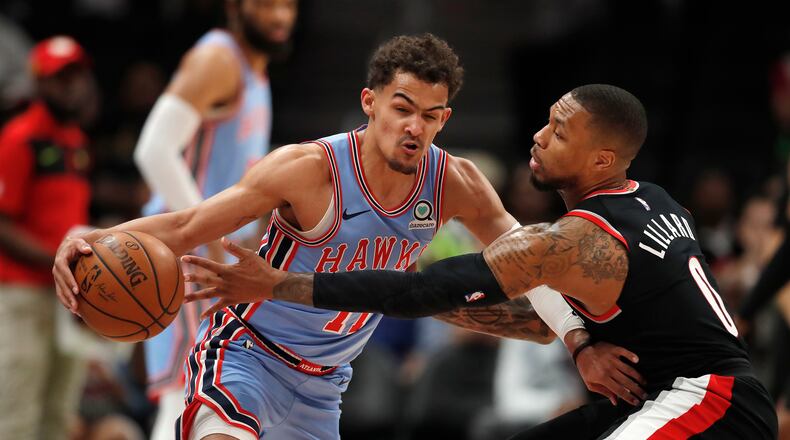The evolution of offense in the NBA has required some defensive compromises. It’s not feasible for every shot to be contested when so many players on the court can dribble, pass and shoot. There’s just too much space and pace to keep up and cover it all, so defenses are forced to make trade-offs.
Now comes a new development, one that bodes well for the Hawks. If it’s difficult to guard open shooters at the 3-point line, what happens when a player can make shots several feet beyond it at a good clip? That distort defenses even more, creating even more offensive space.
Trae Young had that effect during his rookie season. Young did it for a bad team, but the Hawks won’t stay bad for very long with Young as their point guard. And you can see in these NBA playoffs how Young’s unlimited shooting range will pay off for the Hawks once they are good enough to make it there.
Trail Blazers star Damian Lillard is redefining the “space” that must be guarded. Through nine playoff games (not including the game late Tuesday at Denver) Lillard attempted 10 shots from 30 feet or longer and made seven, according to Basketball Reference. One of those was a half-court heave, so really Lillard made seven of nine 30-footers.
Lillard’s most important long-range shot eliminated Oklahoma City from the first round of the Western Conference playoffs. After Lillard made that 36-footer, Thunder star Paul George bitterly complained that it was a bad shot. But really it was poor defense by George because Lillard can make them from distances that few other players attempt while not under duress.
That's the point Lillard made when, in responding to George's gripe, he noted that he practices those shots all the time. It echoed Hawks coach Lloyd Pierce's comments in December when I asked him if he was OK with Young's shot selection considering his deep shooting slump. Pierce said he had no issue with the shots, but directed Young top focus on practicing the pull-up looks from 3 that he was getting in games.
I was skeptical, but it turned out Pierce was right to encourage Young to keep shooting from deep.
Per Basketball Reference Young attempted 70 shots (!) from 30 feet or longer this season, most in the league, and made 24 (34.3 percent). That's better accuracy than Lillard (31 percent on 49 attempts). It's better than Stephen Curry (31 percent on 61 attempts).
I had little doubt that Young would be an immediate hit as an NBA playmaker. I underestimated his ability to make the hardest jump shots in basketball, pull-up 3-pointers. No way did I think Young would take as many as 70 shots from 30 feet or longer and make them at a percentage that wasn’t much worse than the league average on all 3-pointers (35.5 percent).
Admittedly, 30 feet is an arbitrary distance, but there is some logic to using it because NBA advanced stats consider a shot "wide open" if no defender is within six feet. By that definition, a player who shoots from 30 feet with a defender at the 3-point line will always be wide open. Most of them should be: league-wide, players only made 24.9 percent of their attempts from 30 to 40 feet, according to ESPN data.
Young isn’t like most players. His shooting range puts him on a level with Lillard and Curry, and he’s only 21 years old. Young shot a higher percentage than those two from 30-feet plus while attempting more of them and playing alongside lesser teammates.
Defenders can crowd Young well beyond the 3-point line but that can create more problems. He’s already a more productive passer than Lillard and Curry. Opponents blitzed and trapped Young often this season and he eventually learned to make them pay for it with his superlative ball-handling and court vision.
The Hawks drafted a point guard who came ready-made as a passer. By the end of his rookie season he also figured out how to score around the basket and earn free throws. That Young also is a legitimate threat to pull up from 30 feet is a bonus and makes the other elements of his game more effective.
The advantages of having a player like Young became obvious as he developed through his rookie season. To see what that might look like when the Hawks are a better team, just look at what Lillard is doing for the Blazers in the playoffs.
About the Author
The Latest
Featured


